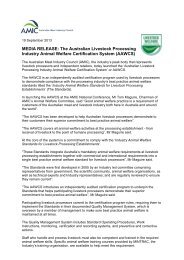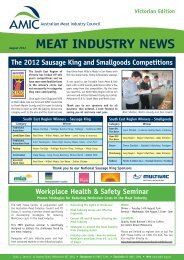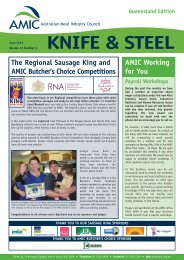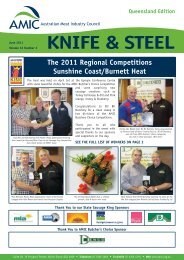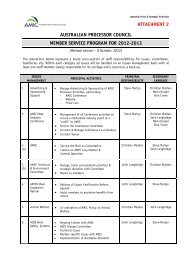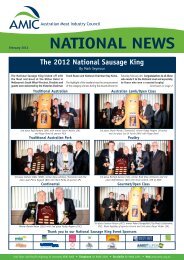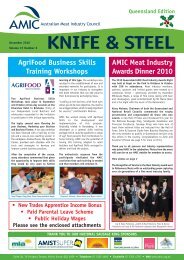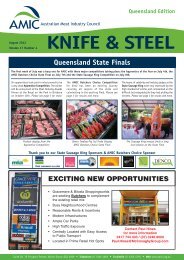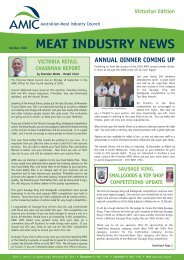Animal Welfare Standards - Australian Meat Industry Council
Animal Welfare Standards - Australian Meat Industry Council
Animal Welfare Standards - Australian Meat Industry Council
Create successful ePaper yourself
Turn your PDF publications into a flip-book with our unique Google optimized e-Paper software.
AUDIT CHECKLIST<br />
Principle<br />
Reference<br />
P3.3 Are personnel handling<br />
livestock on a daily basis<br />
regularly competent to:<br />
• identify abnormal<br />
behaviours, injuries<br />
and signs of stress in<br />
livestock?<br />
• take action when required<br />
to rectify a problem?<br />
P3.4 Are personnel handling<br />
livestock who use<br />
implements and/or<br />
dogs to move animals<br />
competent in their<br />
appropriate use?<br />
P3.5 Are personnel that are<br />
competent in humane<br />
destruction available<br />
and/or are able to be<br />
contacted for prompt<br />
action as required?<br />
P3.6 Are personnel involved in<br />
stunning and slaughter<br />
competent in recognising<br />
the effectiveness of the<br />
procedure (eg. signs of<br />
insensibility)?<br />
P4.1,<br />
P4.6<br />
P4.2,<br />
P4.3<br />
(and 5.5)<br />
Principle Target<br />
Are expectations for assuring<br />
that livestock are fit for<br />
the intended journey are<br />
communicated to livestock<br />
suppliers?<br />
Are consignments of<br />
livestock assessed and<br />
any weak, ill or injured<br />
animals identified and<br />
recorded?<br />
30 For approved methods, refer to Appendix 5.<br />
Personnel handling livestock are competent to:<br />
• routinely inspect livestock;<br />
• identify simple behavioural and physiological signs of stress,<br />
disease and injury;<br />
• take action as necessary.<br />
Personnel handling livestock have undergone on the job training in<br />
the appropriate use of implements (by another competent person<br />
on the premises). Refer to 5.5 for further information.<br />
There is at least one person recorded as competent in the approved<br />
methods for humane destruction 30 .<br />
Current contact details of ‘on-call’ personnel are available to<br />
livestock suppliers, contractors and staff as necessary.<br />
Personnel are trained and competent in recognising:<br />
• effectiveness of the stun and<br />
• maintenance of insensibility from stun to stick.<br />
There should be at least two people that work in slaughter positions<br />
who are trained in recognising successful stun on the floor at all times.<br />
The establishment advises livestock suppliers of:<br />
• the plant’s expectations for assessing the ‘fitness’ of livestock to<br />
be loaded<br />
• associated legal requirements 31 for the loading and transport of<br />
livestock<br />
• any livestock that do not conform to specifications<br />
• any adverse animal welfare outcomes<br />
Records are kept of any weak, ill or injured animals arriving at the<br />
plant.<br />
Inspection and ante-mortem procedures are in place to ensure that<br />
any weak, ill, injured or diseased livestock are identified.<br />
31 Refer to the <strong>Australian</strong> <strong>Standards</strong> and Guidelines for the <strong>Welfare</strong> of <strong>Animal</strong>s – Land Transport, for further information.<br />
46<br />
Yes<br />
No<br />
N/A<br />
INDUSTRY ANIMAL WELFARE STANDARDS




